Comparison of Hydrogen Sulfide Concentrations and Odor Annoyance Frequency Predictions Downwind from Livestock Facilities
Abstract
1. Introduction
2. Experiments
2.1. Farms
2.2. Monitoring Approach
2.3. Odor Annoyance Frequency
2.4. Analysis and Comparison Methods
3. Results
3.1. Dairy Case Study
3.1.1. Weather Conditions
3.1.2. Hydrogen Sulfide Concentrations
3.1.3. Comparison to Odor Annoyance Frequencies
3.2. Swine Case Study
3.2.1. Weather Conditions
3.2.2. Hydrogen Sulfide Concentrations
3.2.3. Comparison to Odor Annoyance Frequencies
4. Discussion
- Continuous H2S (or other appropriate gas) sampling can help establish dispersion conditions and patterns for specific sources and receptors. Time-consuming and costly odor sampling points and times then can be judiciously chosen.
- Additional case studies may strengthen the relationship for the onset of estimated odor annoyance with hydrogen sulfide concentration ranges.
5. Conclusions
- The H2S concentrations near the source were higher during the day, whereas H2S concentrations near downwind receptors were higher during stable and neutral nighttime conditions.
- The H2S concentrations were generally related to proximity to the source and a lack of topographical obstructions.
Supplementary Materials
Author Contributions
Funding
Acknowledgments
Conflicts of Interest
References
- Schauberger, G.; Piringer, M.; Petz, E. Separation distance to avoid odour nuisance due to livestock calculated by the Austrian odour dispersion model (AODM). Agric. Ecosyst. Environ. 2001, 87, 13–28. [Google Scholar] [CrossRef]
- Von Essen, S.G.; Auvermann, B.W. Health effects from breathing air near CAFOs for feeder cattle or hogs. J. Agromedicine 2005, 10, 55–64. [Google Scholar] [CrossRef] [PubMed]
- Starmer, E. Environmental and Health Problems in Livestcok Production. Available online: http://www.ase.tufts.edu/gdae/Pubs/rp/AAI_Issue_Brief_2_1.pdf (accessed on 12 October 2019).
- Pennsylvania State University. Odor Management in Agriculture and Food Processing; Pennsylvania State University: State College, PA, USA, 2002. [Google Scholar]
- Anderson-Bereznicki, S.D. Development of a Multiple-Source Odor Setback Model for Livestock Production Systems; Purdue University: West Lafayette, IN, USA, 2009. [Google Scholar]
- Watts, P.; Sweeten, J. Toward a better regulatory model for odour. In Proceedings of the Feedlot Waste Management Conference, Queensland, Australia, 12 June 2005. [Google Scholar]
- South Dakota State University. South Dakota Odor Footprint Tool. Available online: https://www.sdstate.edu/agricultural-and-biosystems-engineering/south-dakota-odor-footprint-tool (accessed on 12 October 2019).
- Jacobson, L.; Schmidt, D.R. Odor from Feedlots Setback Estimation Tool—OFFSET. Available online: http://www.milkproduction.com/Library/Scientific-articles/Housing/OFFSET-Odor-From-Feedlots-Setback-Estimation-Tool/ (accessed on 12 October 2019).
- University of Nebraska-Lincoln. Odor Footprint Tool. Available online: https://water.unl.edu/manure/odor-footprint-tool (accessed on 2 December 2019).
- Purdue University. Livestock Odor Setback Model—Purdue University. Available online: https://engineering.purdue.edu/~odor/setback.htm (accessed on 2 December 2019).
- Brewer, M.S.; Cadwallader, K.R. Overview of Odor Measurement Techniques; University of Illinois, Department of Food Science & Human Nutrition: Urbana, IL, USA, 2004; p. 61801. [Google Scholar]
- Nicolai, R.E.; Pohl, S.H. Understanding Livestock Odors. Available online: https://www.sdstate.edu/sites/default/files/abe/research/structures/upload/FS925-A.pdf (accessed on 10 May 2017).
- Parker, D.B. Reduction of Odor and Voc Emissions from a Dairy Lagoon. Appl. Eng. Agric. 2008, 24, 647–655. [Google Scholar] [CrossRef]
- Guo, H.; Jacobson, L.; Schmidt, D.; Nicolai, R. Evaluation of the influence of atmospheric conditions on odor dispersion from animal production sites. Trans. ASAE 2003, 46, 461. [Google Scholar]
- Maurer, D.L.; Bragdon, A.M.; Short, B.C.; Ahn, H.; Koziel, J.A. Improving environmental odor measurements: Comparison of lab-based standard method and portable odor measurement technology. Arch. Environ. Prot. 2018, 44, 100–107. [Google Scholar] [CrossRef]
- Akdeniz, N.; Jacobson, L.D.; Hetchler, B.P.; Bereznicki, S.D.; Heber, A.J.; Koziel, J.A.; Cai, L.; Zhang, S.; Parker, D.B. Odor and odorous chemical emissions from animal buildings: Part 4. Correlations between sensory and chemical measurements. Trans. ASABE 2012, 55, 2347–2356. [Google Scholar] [CrossRef]
- Barth, C.; Hill, D.; Polkowski, L. Correlating odor intensity index and odorous components in stored dairy manure. Trans. ASAE 1974, 17, 742–0744. [Google Scholar] [CrossRef]
- Lu, P.; Su, Z.; Wang, G.; Dai, Z.; Zhang, Z.; Yu, C.; Liu, J.; Wang, Z.; Qin, L.; Nie, Z. VOCs analyzing and odor indicator selecting in ambient air of landfill area. Huan Jing Ke Xue Huanjing Kexue 2011, 32, 936–942. [Google Scholar]
- Lunn, F.; Van De Vyver, J. Sampling and analysis of air in pig houses. Agric. Environ. 1977, 3, 159–169. [Google Scholar] [CrossRef]
- Ostojic, N.; O’Brien, M.; Schmidt, C.E. Relationship between odor and hydrogen sulfide emissions at a water pollution control plant in New York city. In Proceedings of the Water Environment Federation, Alexandria, VA, USA, 14–18 October 2000; pp. 8–21. [Google Scholar]
- Qamaruz-Zaman, N.; Milke, M. VFA and ammonia from residential food waste as indicators of odor potential. Waste Manag. 2012, 32, 2426–2430. [Google Scholar] [CrossRef]
- Riskowski, G.; Chang, A.; Steinberg, M.; Day, D. Methods for evaluating odor from swine manure. Appl. Eng. Agric. 1991, 7, 248–253. [Google Scholar] [CrossRef]
- Zhu, J.; Jacobson, L.D. Correlating microbes to major odorous compounds in swine manure. J. Environ. Qual. 1999, 28, 737–744. [Google Scholar] [CrossRef]
- Zhu, J.; Riskowski, G.; Torremorell, M. Volatile fatty acids as odor indicators in swine manure—A critical review. Trans. ASAE 1999, 42, 175. [Google Scholar] [CrossRef]
- Filipy, J.; Rumburg, B.; Mount, G.; Westberg, H.; Lamb, B. Identification and quantification of volatile organic compounds from a dairy. Atmos. Environ. 2006, 40, 1480–1494. [Google Scholar] [CrossRef]
- Guo, H.; Jacobson, L.D.; Schmidt, D.R.; Nicolai, R.E. Correlation of odor dilution threshold and H2S and NH3 concentrations for animal feedlots. In Proceedings of the 2000 ASAE Annual International Meeting, Milwaukee, WI, USA, 7 September–7 December 2000; pp. 4085–4095. [Google Scholar]
- Hobbs, P.; Misselbrook, T.; Pain, B. Assessment of odours from livestock wastes by a photoionization detector, an electronic nose, olfactometry and gas chromatography-mass spectrometry. J. Agric. Eng. Res. 1995, 60, 137–144. [Google Scholar] [CrossRef]
- Williams, A. Indicators of piggery slurry odour offensiveness. Agric. Wastes 1984, 10, 15–36. [Google Scholar] [CrossRef]
- Minnesota Office of the Revisor of Statutes. 7009.0080 Minnesota Ambient Air Quality Standards. Available online: https://www.revisor.mn.gov/rules/7009.0080/ (accessed on 30 December 2019).
- Hofer, B.J. Effect of a Shelterbelt on H2S Concentrations from Swine Barns; South Dakota State University: Brookings, SD, USA, 2009. [Google Scholar]
- Jacobson, L.D.; Guo, H.; Schmidt, D.R.; Nicolai, R.E.; Zhu, J.; Janni, K.A. Development of the OFFSET model for determination of odor-annoyance-free setback distances from animal production sites: Part I. Review and experiment. Trans. ASAE 2005, 48, 2259–2268. [Google Scholar] [CrossRef]
- Guo, H.; Jacobson, L.D.; Schmidt, D.R.; Nicolai, R.E.; Zhu, J.; Janni, K.A. Development of the OFFSET model for determination of odor-annoyance-free setback distances from animal production sites: Part II. Model devlopment and evaluations. Trans. ASAE 2005, 48, 2269–2276. [Google Scholar] [CrossRef]
- Nimmermark, S.A.; Jacobson, L.D.; Schmidt, D.R.; Gay, S.W. Predictions by the Odor From Feedlots, Setback Estimation Tool (OFFSET) compared with observations by neighborhood monitors. J. Air Waste Manag. Assoc. 2005, 55, 1306–1314. [Google Scholar] [CrossRef]
- Gay, S.W.; Schmidt, D.R.; Clanton, C.J.; Janni, K.A.; Jacobson, L.D.; Weisberg, S. Odor, total reduced sulfur, and ammonia emissions from animal housing facilities and manure storage units in Minnesota. Appl. Eng. Agric. 2003, 19, 347–360. [Google Scholar]
- Hunter, C. A Recommended Pasquill-Gifford Stability Classification Method for Safety Basis Atmospheric Dispersion Modeling at SRS; United States Department of Energy, Savannah River Site: Aiken, SC, USA, 2012. [Google Scholar]
- Bailey, D.T. Meteorological Monitoring Guidance for Regulatory Modeling Applications; DIANE Publishing: Darby, PA, USA, 2000. [Google Scholar]
- U.S. Climate Data. Climate South Dakota. Available online: https://www.usclimatedata.com/climate/brookings/south-dakota/united-states/ussd0041/2016/9 (accessed on 10 November 2019).
- Huang, D.; Guo, H. Diurnal and seasonal variations of odor and gas emissions from a naturally ventilated free-stall dairy barn on the Canadian prairies. J. Air Waste Manag. Assoc. 2017, 67, 1092–1105. [Google Scholar] [CrossRef] [PubMed]
- Kim, K.Y.; Ko, H.J.; Kim, H.T.; Kim, Y.S.; Roh, Y.M.; Lee, C.M.; Kim, C.N. Quantification of ammonia and hydrogen sulfide emitted from pig buildings in Korea. J. Environ. Manag. 2008, 88, 195–202. [Google Scholar] [CrossRef] [PubMed]
- Hayes, E.T.; Curran, T.P.; Dodd, V. Odour and ammonia emissions from intensive pig units in Ireland. Bioresour. Technol. 2006, 97, 940–948. [Google Scholar] [CrossRef] [PubMed][Green Version]
- Capelli, L.; Sironi, S.; Del Rosso, R. Odor sampling: Techniques and strategies for the estimation of odor emission rates from different source types. Sensors 2013, 13, 938–955. [Google Scholar] [CrossRef] [PubMed]
- Nagata, Y.; Takeuchi, N. Measurement of Odor Threshold by Triangle Odor Bag Method. Available online: http://www.env.go.jp/en/air/odor/olfactory_mm/04ref_2.pdf (accessed on 12 February 2019).
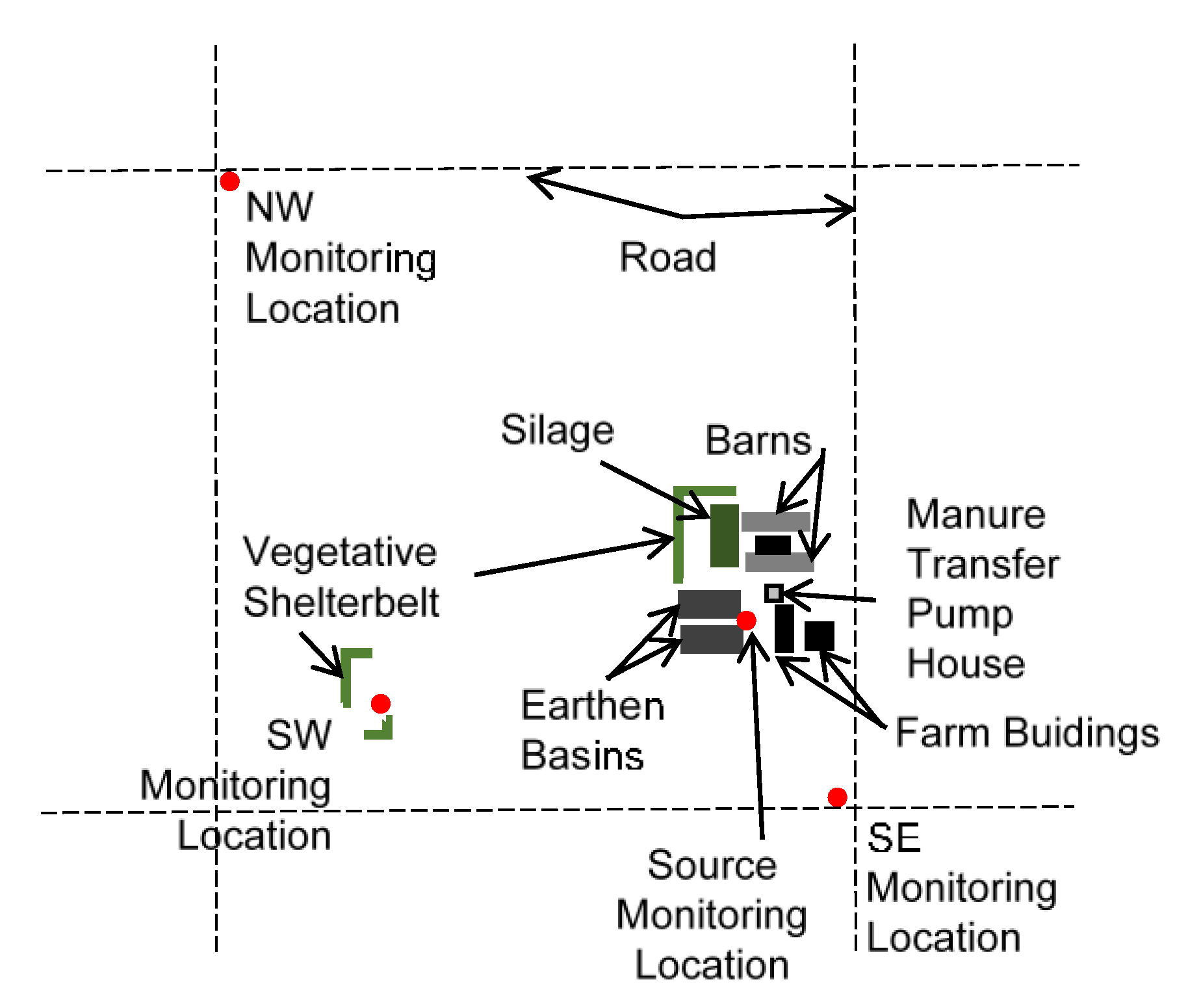
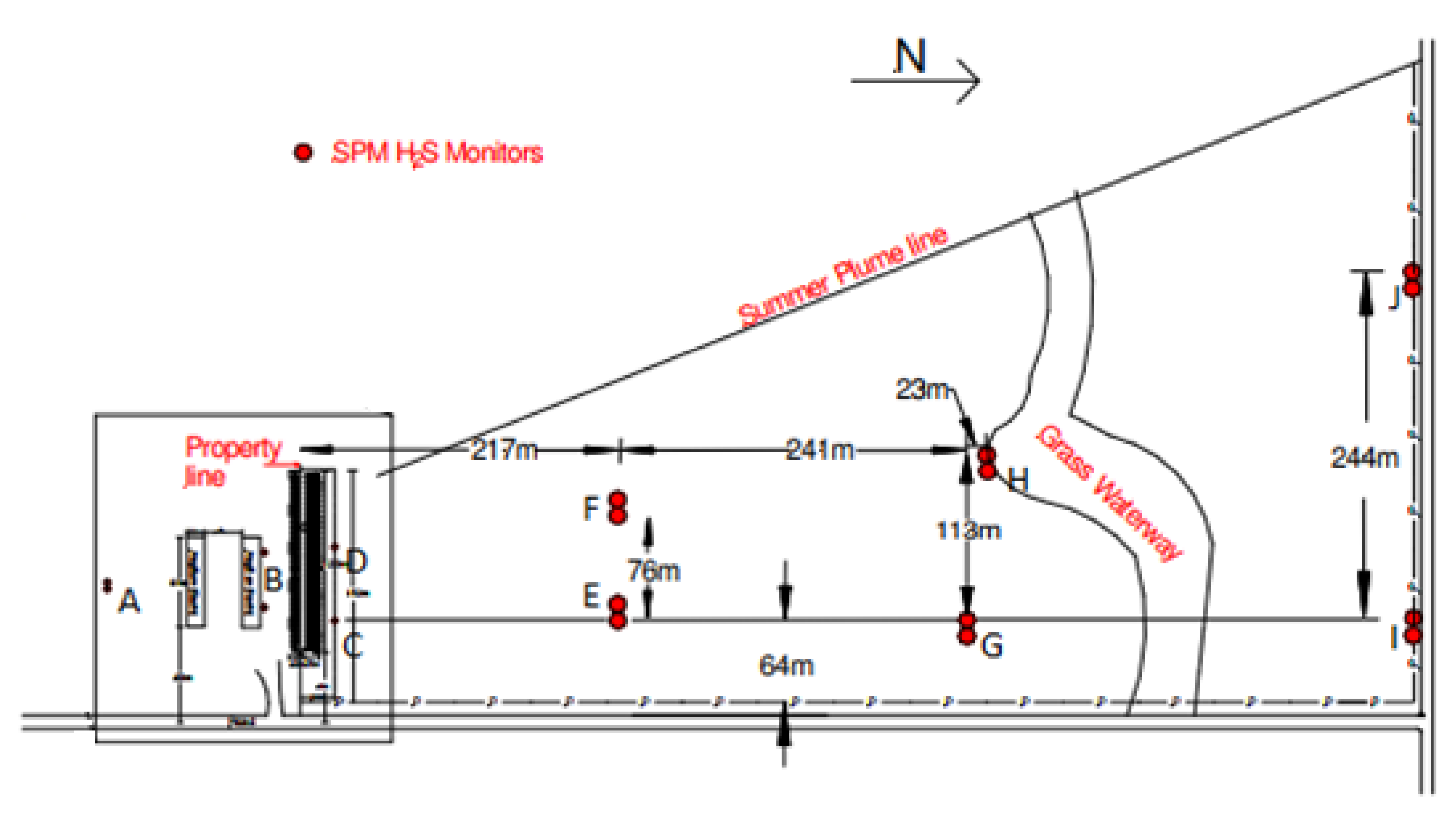
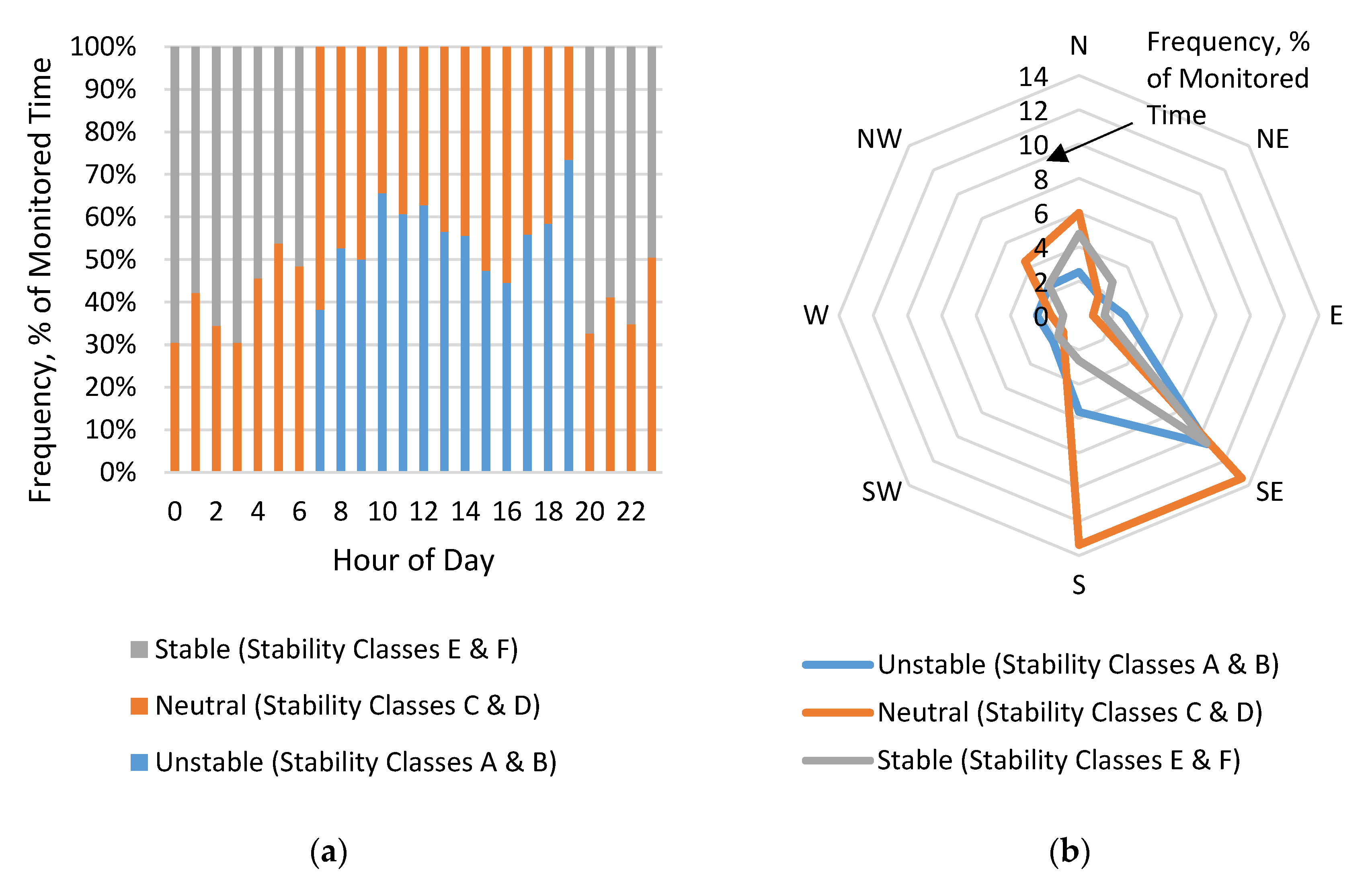
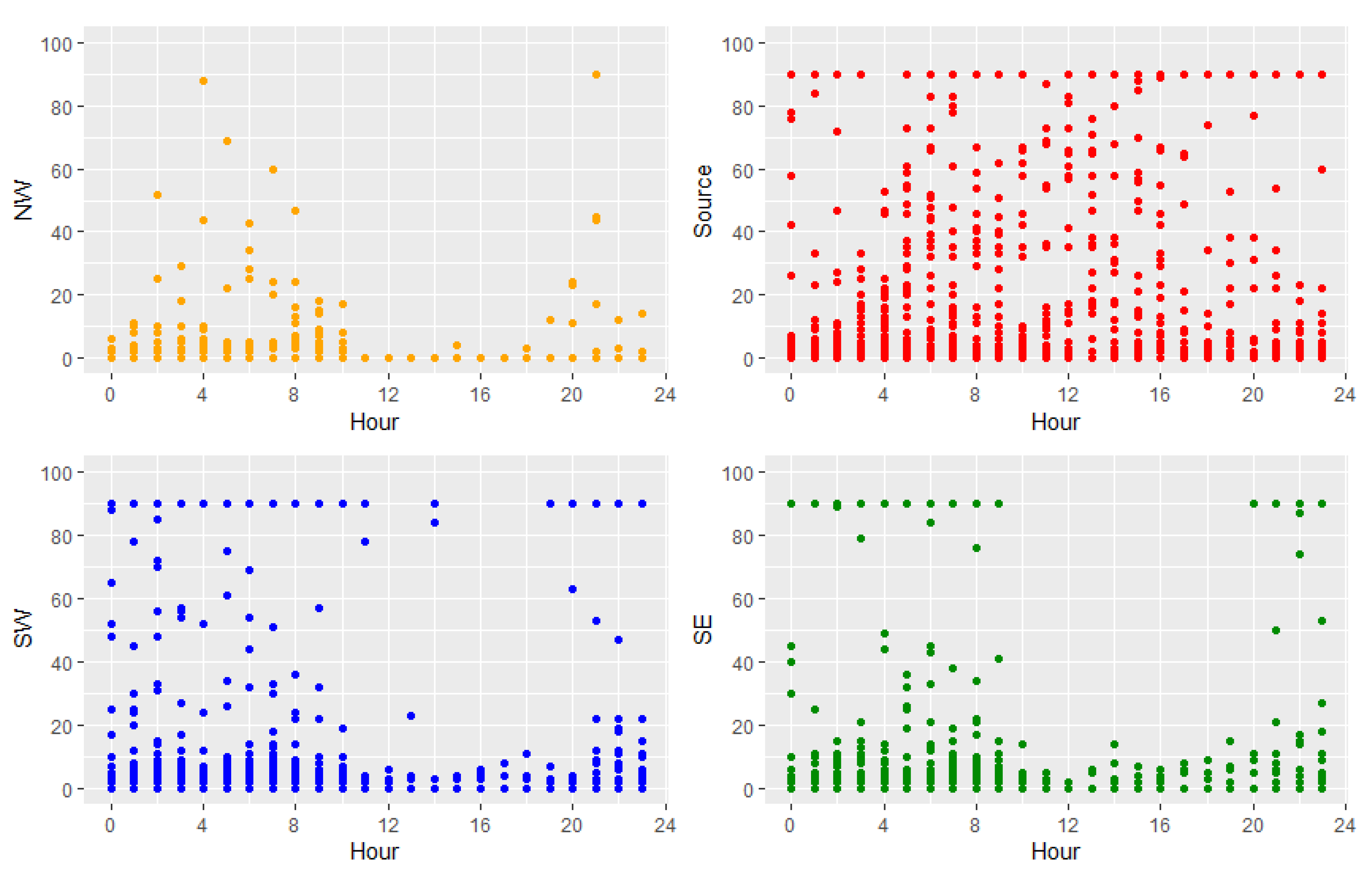
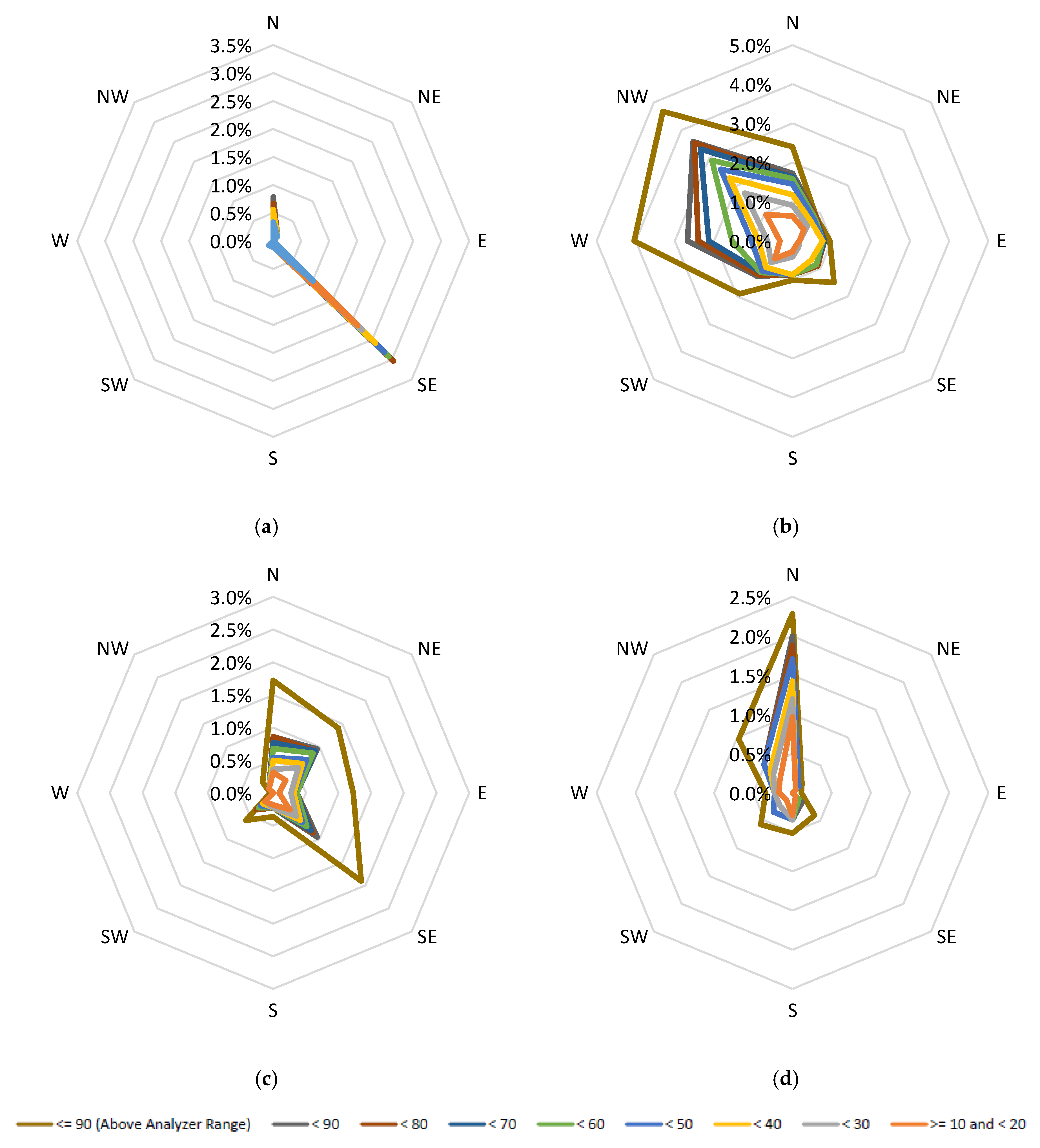
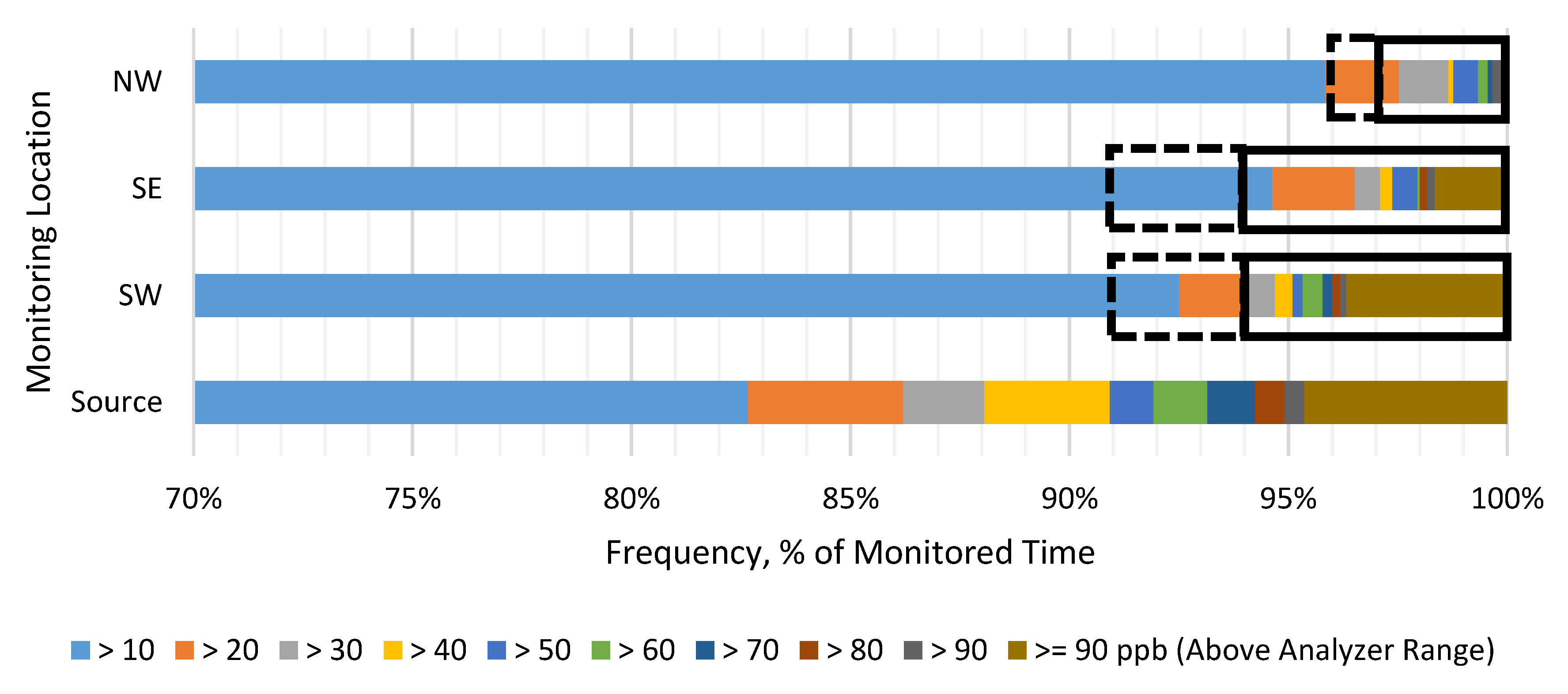
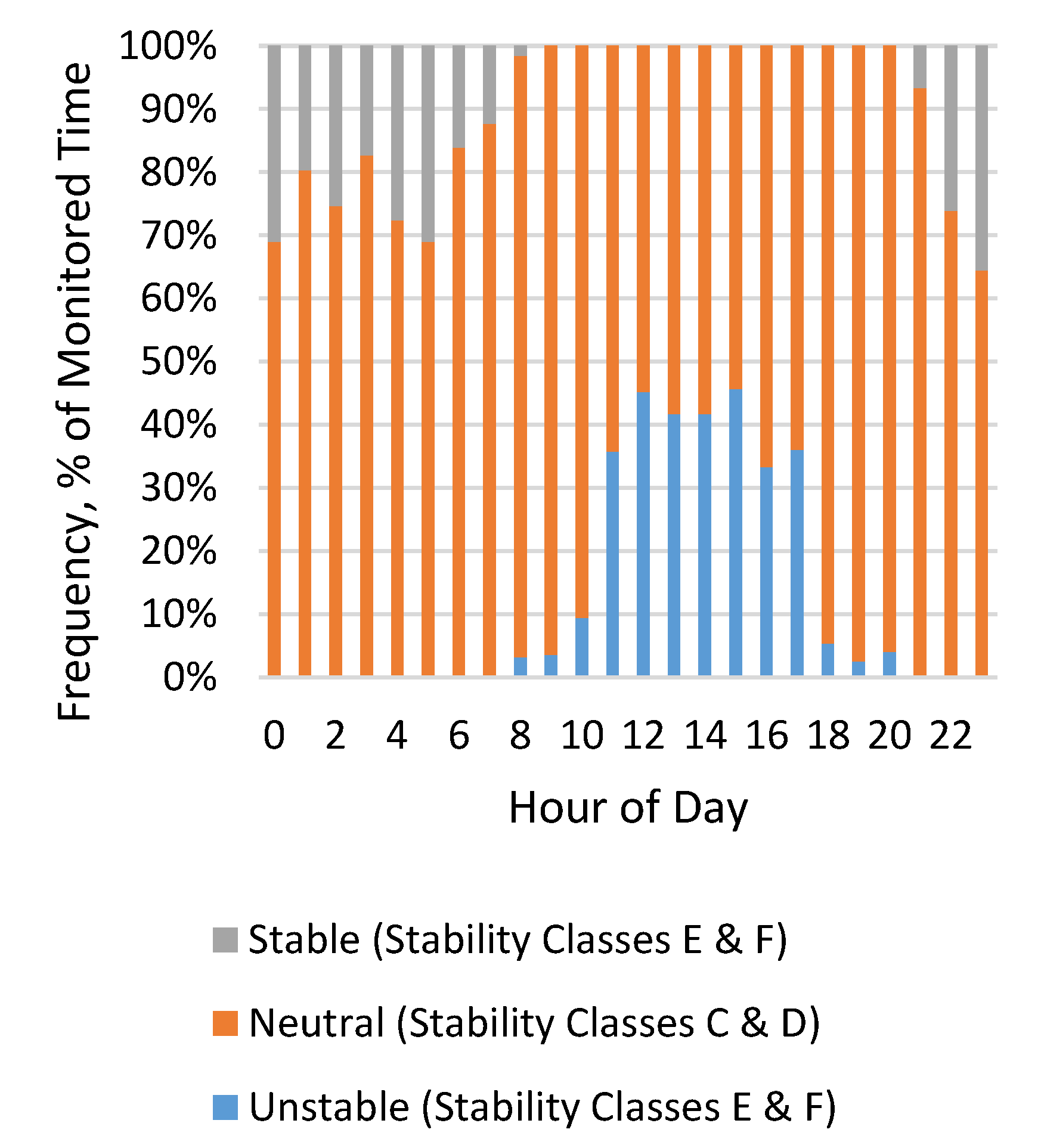
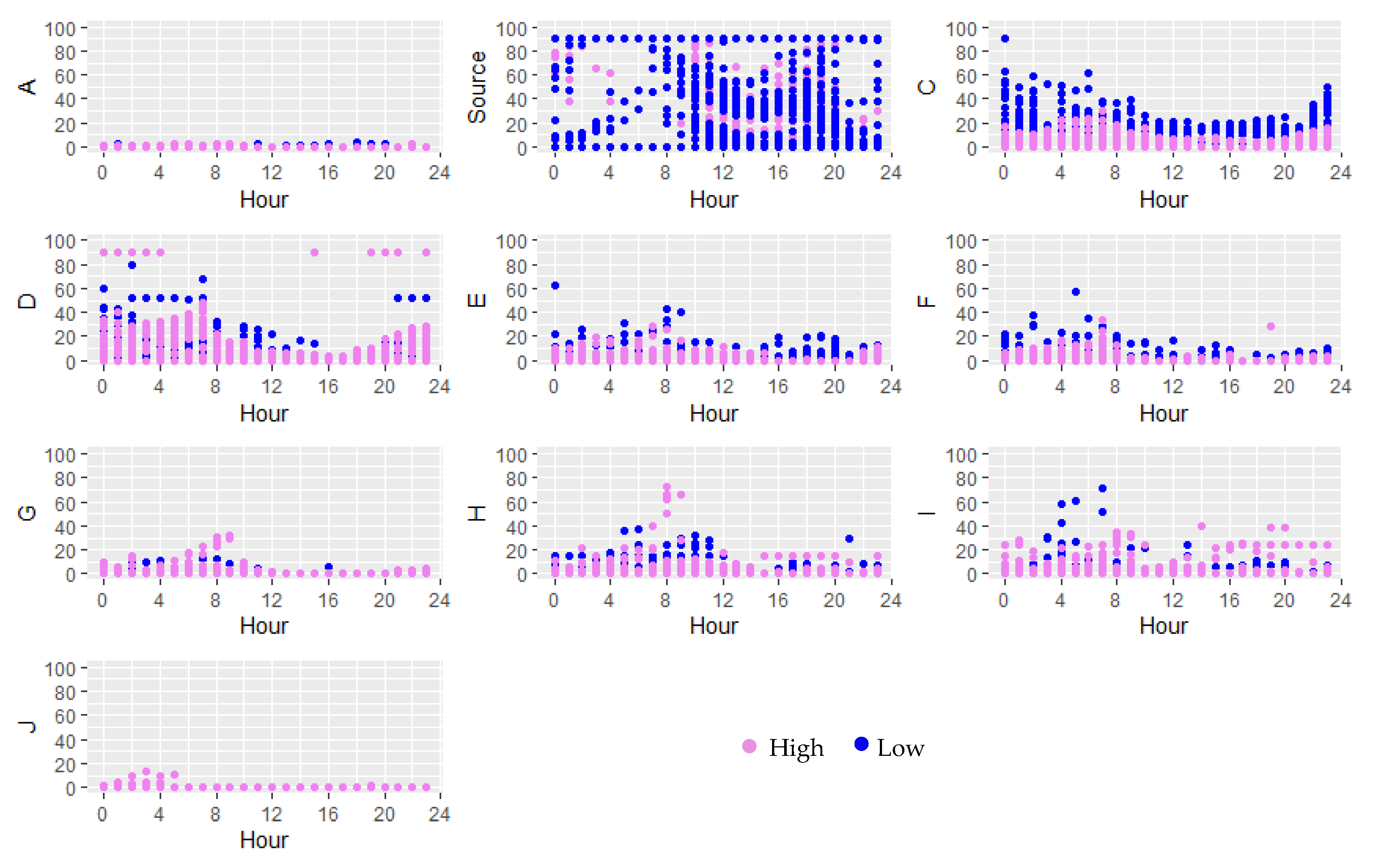
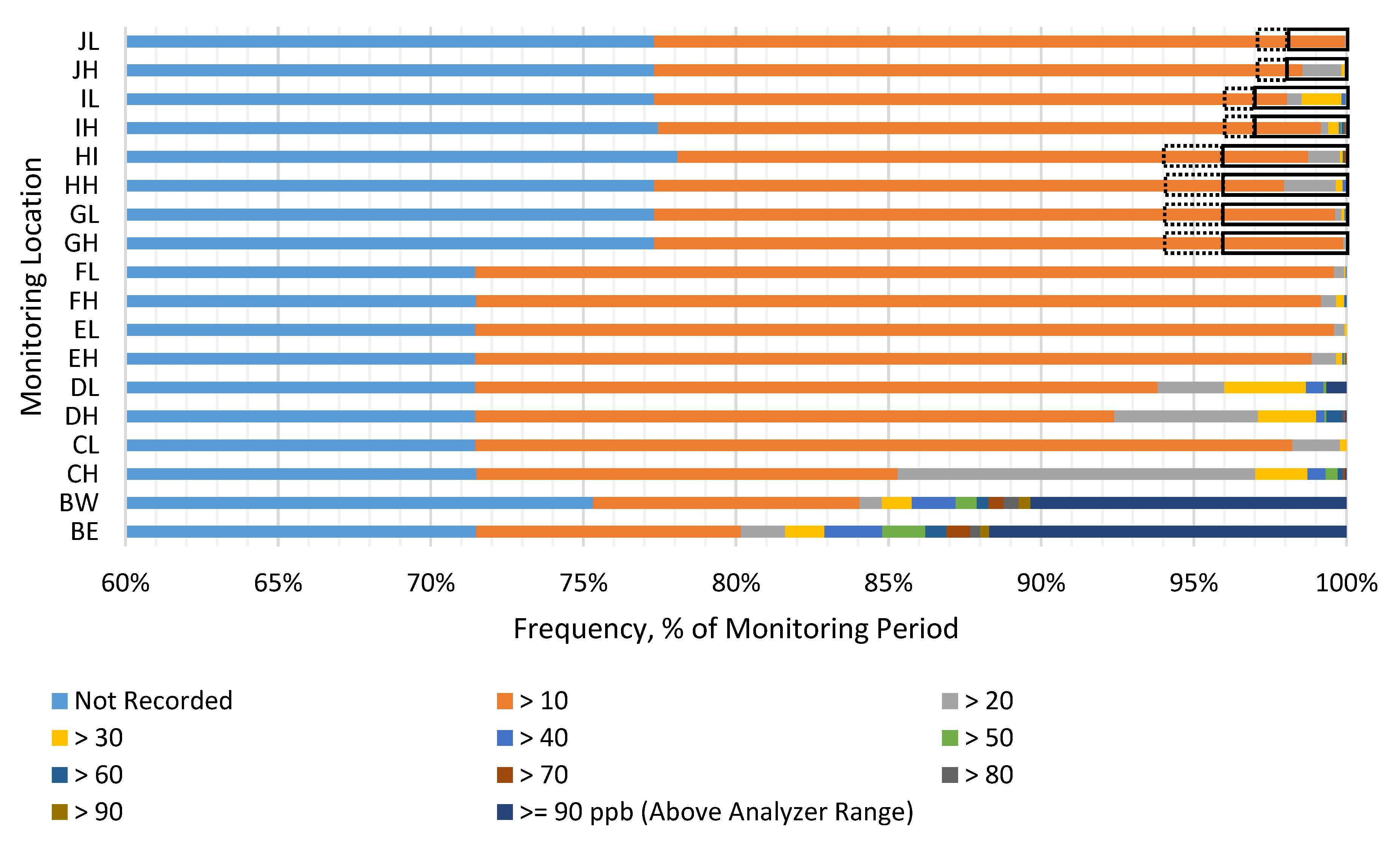
| Case Study | Odor Emission Sources | # of Animals | Type of Animal | Source Description | Source Dimension (Length × Width), m |
|---|---|---|---|---|---|
| Dairy | Barn 1 | 1565 | Dairy cattle | Freestall | 480 × 100 |
| Barn 2 | 320 | 98 × 34 | |||
| Manure storage | 1885 | Earthen basin | 290 × 116 | ||
| Swine | Barn 1 | 1000 | Finisher swine | Deep pit manure storage | 61 × 12 |
| Barn 2 | 1000 | 61 × 12 |
| Monitoring Locations | Distance from Source (m) | Estimated A Odor Annoyance Frequency (% time) |
|---|---|---|
| NW corner | 1658 | 3–4 |
| SW corner | 805 | 6–9 |
| SE corner | 547 | 6–9 |
| Monitoring Locations | Distance from the Source (m) | % of Total Time Having Odor Annoyances Calculated by SDOFT |
|---|---|---|
| B (Source) | Source | >9% |
| C | 82 | >9% |
| D | 82 | >9% |
| E | 247 | >9% |
| F | 257 | >9% |
| G | 510 | 4–6% |
| H | 521 | 4–6% |
| I | 506 | 3–4% |
| J | 842 | 2–3% |
© 2020 by the authors. Licensee MDPI, Basel, Switzerland. This article is an open access article distributed under the terms and conditions of the Creative Commons Attribution (CC BY) license (http://creativecommons.org/licenses/by/4.0/).
Share and Cite
Akter, S.; Cortus, E.L. Comparison of Hydrogen Sulfide Concentrations and Odor Annoyance Frequency Predictions Downwind from Livestock Facilities. Atmosphere 2020, 11, 249. https://doi.org/10.3390/atmos11030249
Akter S, Cortus EL. Comparison of Hydrogen Sulfide Concentrations and Odor Annoyance Frequency Predictions Downwind from Livestock Facilities. Atmosphere. 2020; 11(3):249. https://doi.org/10.3390/atmos11030249
Chicago/Turabian StyleAkter, Suraiya, and Erin L. Cortus. 2020. "Comparison of Hydrogen Sulfide Concentrations and Odor Annoyance Frequency Predictions Downwind from Livestock Facilities" Atmosphere 11, no. 3: 249. https://doi.org/10.3390/atmos11030249
APA StyleAkter, S., & Cortus, E. L. (2020). Comparison of Hydrogen Sulfide Concentrations and Odor Annoyance Frequency Predictions Downwind from Livestock Facilities. Atmosphere, 11(3), 249. https://doi.org/10.3390/atmos11030249





